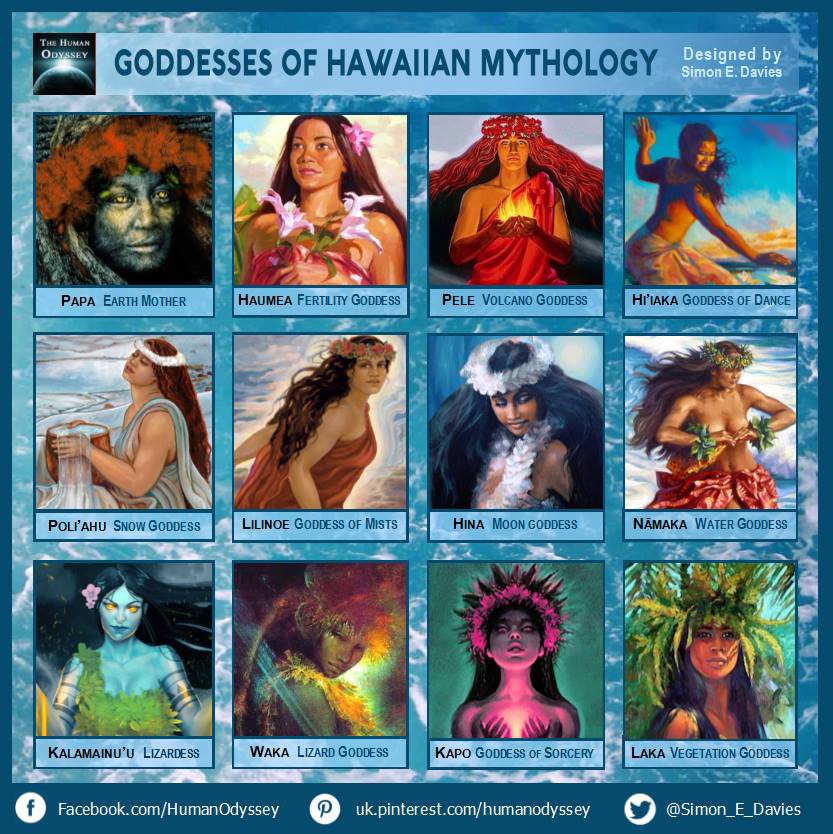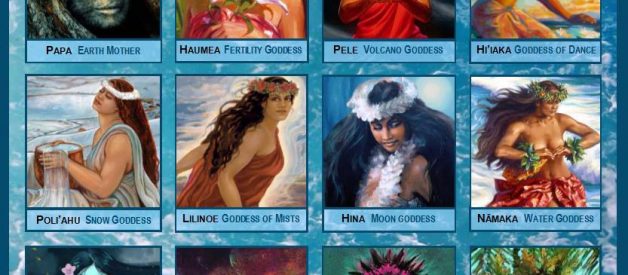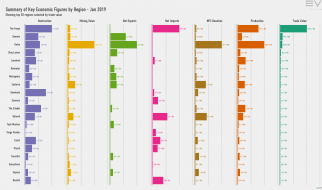Hawaiian mythology is rich with supernatural figures, such as gods and men, or ghosts and goblins. One Hawaiian chant speaks of as many as ?four thousand gods? of the Hawaiian cosmos. The ancient Hawaiians, like most indigenous peoples, felt a deep connection with nature and explained everything from the creation of the Earth to the lava flowing from the volcanoes through the stories of their gods and goddesses.

Papa is the Earth Mother of Hawaiian mythology. Together with her husband W?kea (sky father) she is the ancestor of all people and Kalo, and mother of all islands. Her descendants were the Ariki lines (High ranking Nobles, Kings) of Hawaii, Rarotonga, Aitutaki and the Maori. These lines permeated into all the Isles of Polynesia. Haumea is a fertility goddess who takes many forms in Hawaiian mythology. She is the sister of Kane and Kanaloa and is one of the oldest deities worshiped on the islands. She is often identified as the wife to Kanaloa, god of the underworld. As the goddess of fertility, Haumea is also recognized as the patroness of childbirth. Pele is a Fire Goddess and one of the most revered deities in Hawaiian mythology. She resides over lightning, dance, wind, volcanoes and violence. Her poetic name is Ka wahine ai honua or ?she who devours the land?. She is both a creator and destroyer. She throws molten fountains into the air and governs the great flows of lava. Hi?aka is the younger sister to Pele and patroness of hula dancers, chant, sorcery and medicine. She was born from the mouth of her mother Haumea, in the form of an egg. It was Pele who carried her younger sister under armpit until she matured. Her family line is also called Hi?iaka and they take on the task of bearing the clouds, providing rain, thunder and lightning. Poli?ahu is the goddess of snow, and an enemy of the goddess Pele. She resides on the island Mauna Kea. Poli?ahu met the noble chieftain Aiwohikupua on the Eastern slope of Mauna Kea. The two fell in love and Aiwohikupua took Poli?ahu home to his native Kaua?i. Poli?ahu is defined by her otherworldly beauty and is considered to be one of the most beautiful goddesses in Hawaii. Lilinoe is the goddess of mists and fog. She is the younger sister of Poli?ahu and like her sister, a great rival of volcano goddess Pel. The sisters are the antithesis of Pel: spirits of snowy mountains (hence wet mountains) rather than fiery ones. She also is the goddess of Haleakal?, dead fires, and of desolation. Her name literally means ?fine mist.? Hina is the goddess of the moon. She is described as a smart, beautiful, determined young woman. In her early days, she created bark cloth for her husband, but got tired of being unappreciated for her work. She headed for the moon and found she much preferred his company. Her husband was furious about her infidelity, but the goddess managed to escape and found happiness in the heavens. N?maka is the goddess of the sea. She is the daughter of Ku-waha-ilo and Haumea, whose other children are Pele, the Hi?iaka sisters and the Kama brothers. N?maka and Pele would often quarrel and eventually became enemies. N?maka began sending tidal waves upon Pele?s lands. The fire goddess grew tired of N?maka?s attacks, and eventually managed to overcome her sister, bringing peace back to her islands. Kalamainu?u is a lizard goddess who looks after the lizards of Hawaii. She once Puna-ai-koa?e, to her cave where she kept him prisoner. He managed to procure his freedom for a day, but was warned not to speak with anyone. As soon as he left, however, he spoke with friends who told him his lover?s true nature. He returned to her cave and saw Kalamainu?u in her lizard form. He accepted her and became her lover, but in a rage, she killed the informants. Waka is another lizard goddess who is worshipped by the female chiefs of Hawaii. Legend says she was sent in the form of an eel to bar Lono-kai from the land of K??ai-he-lani. When Lono-kai caught the eel, he cut it open and a beautiful woman emerged who attempted to seduce him. In the L??ie-i-ka-wei narrative, Waka acts as the guardian of a beautiful girl until she can find her a suitable husband. Kapo is a goddess of sorcery and black magic. She was born of Papa (or Haumea), and is the mother of Laka, and her sister?s are Milohai, Kamohoali?i, Pele, N?maka and Hi?iaka. She once saved Pele from being raped by Kama-pua?a by sending her flying vagina as a lure. Kapo is also proficient in the arts of herb medicine. Laka is a fertility goddess who resides over forests, vegetation, rain, love, music and Hula. She is the daughter of Kapo, and wife of Lono. Laka is best known for creating the Hula, which is a dance form accompanied by chant or song (known as mele). As a vegetation Goddess she is associated with the nourishing elements of light and rain.


